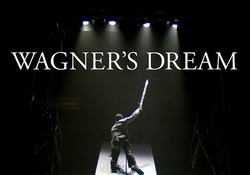
This well produced documentary neatly traces the collaboration of Canadian designer Robert Lepage and the Metropolitan Opera from its inception to the final staging of Wagner’s Ring Cycle.
Just as the Met’s Ring Cycle is dominated by the Machine, so too is Wagner’s Dream. And, without doubt, the film does a fine job of showing how Lepage’s set works. The camera admiringly captures it in all its elegance, grandeur and brute force. We see it from the front and the back, up close and at a distance. It is indeed a fascinating and impressive thing. However, this is exactly what some critics say is wrong with the Machine: it so completely overwhelms the production that other aspects of this Ring (i.e. the singing and acting) are in its shadow.
Similarly, the mere humans in this film – Lepage, general director Peter Gelb, conductor James Levine, and even such major opera stars as Bryn Terfel and Deborah Voigt – are dwarfed in comparison with the Machine. Their petty concerns are nothing compared with the kinetic imperatives of the set’s massive planks.
Most of the “unpleasant” parts of the film – obstacles, conflicts, disasters and near disasters – are concerned with the most obvious challenges this Ring has faced. It’s well known that the Machine didn’t operate as planned on the opening night of Rheingold. And everyone who cares to know already knows that Voigt tripped and fell on the stage during Die Walküre, and that Jay Hunter Morris had to step in at the last minute as Siegfried.
However, what about problems that are less obvious? Can Froemke tell us anything we don’t already know?
The kind of behind-the-scenes tensions that the best documentaries sink their teeth into are only hinted at here. We see Lepage expressing a soupçon of frustration at the Met’s stagehands’ attempts to operate the Machine. We see a nervous character (either Fasolt or Fafner – it’s hard to tell) very sensibly expressing doubts about his personal safety during a rehearsal of Rheingold. And we see a few short interviews with unhappy Met patrons who don’t get what Lepage is getting at.
What we don’t see is trenchant commentary from any of the critics who have lined up against the Met’s Ring, or against Gelb’s administration at the Met. (See here and here.) We also don’t see much intense discussion between Lepage and Gelb about the Machine’s ongoing problems – or get a sense of the weight of responsibility they jointly shoulder (which, in financial terms alone, is enormous). Nor for that matter do we see any kind of backstage drama that rises above a tepid temperature.
In the end, Wagner’s Dream looks like two hours of slick, sanitized, pro-Met propaganda. I don’t know if that’s what Froemke intended from the outset, or whether it just came out this way. And I’m left wondering how much access she had to all that was happening inside the Met as this Ring was prepared for staging – and what kind of “deal” she had to strike to get any access at all.
© Colin Eatock 2012
 RSS Feed
RSS Feed

